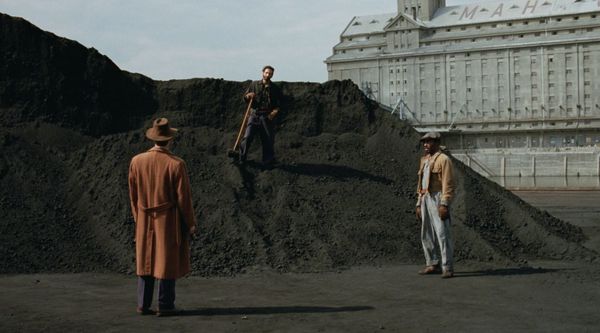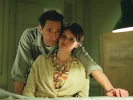Eye For Film >> Movies >> The Brutalist (2024) Film Review
The Brutalist
Reviewed by: Anne-Katrin Titze

Brady Corbet’s ferocious love of cinema is felt every minute in The Brutalist, which won the director the Silver Lion at this year’s Venice International Film Festival and is a highlight in the Main Slate programme of the 62nd New York Film Festival. Co-written with Mona Fastvold, the film stars a virtuoso Adrien Brody who is accompanied by the swell ensemble cast of Felicity Jones, Guy Pearce, Alessandro Nivola, Stacy Martin, Joe Alwyn, Raffey Cassidy, Emma Laird, and Isaach De Bankolé.
Corbet’s go-to cinematographer Lol Crawley (Childhood Of A Leader, Noah Baumbach’s White Noise, Andrew Haigh’s 45 Years), together with the formidable production design by Judy Becker (Todd Haynes’s Carol, David O Russell’s American Hustle) create a 70mm tableau that functions as a palimpsest of memories and dreams, realities and archives. A past shines through another layer of the past into a silver screen present that is both familiar and brand-new. The music by composer Daniel Blumberg blends with the often disquieting sound design, and cheery original songs from mid-century America.

When the VistaVision logo - in just the right shades of blue and yellow - pops onto the screen, the heart begins to flutter. Triggered by this visual madeleine, we already forecast extraordinary things ahead (Alexander Payne’s longtime fabulous graphic designer Nate Carlson produced a similar jolt with the logos resembling another decade at the start of last year’s The Holdovers). It is the remembrance of joyous anticipation that catapults us into movie magic. This is the dangerous kind and the director and his team work wonders conjuring up various overlapping histories and futures at once.
The overture consists of an alarm, while disturbing sounds accompany a soft female voice-over of a letter, informing a man named László, that she, his wife, is still alive and that his niece Zsófia is with her. She writes that “Soviet boys like us,” which appears to be a good sign, and quotes Goethe: “None are more hopelessly enslaved than those who believe that they are free.” It could stand as a motto for much of what is to come in The Brutalist. A scene of chaos may make one think of the beginning of László Nemes’s Son Of Saul, but instead of the gates of hell, it is Lady Liberty, albeit in topsy-turvy rotation, that announces the arrival of once famous Hungarian architect László Tóth (Adrien Brody) on Ellis Island, the entryway to the land of the free.
Part One of László’s journey from 1947 to 1952, called The Enigma Of Arrival (also the title of VS Naipaul’s autobiographical novel) leads him to Pennsylvania (introduced effectively by a tourist newsreel of the time). Brody’s performance is raw and tender and fragile and heartbreaking. His rawness is matched by Alessandro Nivola as László’s cousin Attila, who picks him up from the bus. The hug the two men share doesn’t feel like a movie hug. It is as though both actors for an instant had sudden access to a deep well of ancestral traumas and we believe at this moment that one man welcomes another, who was believed dead, but actually escaped from the Acheron. Ancient myth suffuses this embrace.
Attila owns a furniture store, called Miller & Sons. He himself is Miller and there are no sons, but “folks here like a family business.” Attila emigrated long before the war and has since converted to Catholicism to please his wife Audrey (Emma Laird). He lets his cousin sleep next to the showroom and you can feel the tension rising between the two, without any over-explanation as is so often the case in other movies that feel the need to spell out everything. It is purely the fantastic performances that give us a sense of the men’s rivalry in the past. The genius architect who studied with the Bauhaus greats in Dessau and the cousin who left home to start fresh in the new world clearly care for each other and despise each other in a variety of ways.
László on the breadline for a soup kitchen meets Gordon (Isaach de Bankolé) and his small son. The two men will be friends for decades. A job offer for Attila and László from Harry Lee Van Buren (Joe Alwyn) to remodel, as a surprise, the library at his father’s country estate, turns out to be life-changing. Industrialist Harrison Lee Van Buren (Guy Pearce), at first furious about not having been informed, will become a dominating force in László’s life and career. The 1950s are fast approaching and big colorful ties, as though designed by Sonia Delaunay (costumes by Kate Forbes), suit the master of the castle. He is in control and enjoys it.
Post-war energy is flying high. Attila and his wife perform a wild dance to the song “Buttons & Bows” in their living room. Attila, wearing his wife’s kitchen apron, urges László to dance with her. Tensions peak and motivations remain unclear, which makes the scene extra powerful. We in the audience are put in the position of children who, awoken by the noise, sneak downstairs to watch the adults perform a mysterious dance that is equally disturbing and fascinating. The half-understood is what creats many a memory to be unearthed decades later. “It’s so nice to have a man around the house” is Audrey’s favorite song, according to her husband, and when she tells László that he is not what she expected, he responds that “I’m not what I expected either.”
Family is complicated and László finds himself in a shelter run by a church, together with Gordon, and working on a construction site. Another song of the time pierces through the repressed. “To Each His Own” we hear, melancholy, sweet, and melodic. “Jedem das Seine”, the German translation, was the motto inscribed at the entrance to the Buchenwald concentration camp. Corbet creates the palimpsest this way, avoids the pitfalls, and doesn’t take his audience for stupid. We figure out what we figure out, there is space for an abundance of connections. While Jonathan Glazer’s The Zone Of Interest stayed in next-door proximity to the death camps to let the horrors unfold in each viewer’s mind, The Brutalist transports the impact across the seas in actions, decisions, and buildings made from concrete.
In a diner with bright cherry-red tables and seafoam-green walls, Van Buren Sr. presents his research on László’s past. Flattering German newspaper articles and photographs on his buildings and former career are shown to him and to us. Seeing in print his family name, Tóth, which sounds like the German word for death, “Tod”, in a flash made me think of a line from Paul Celan’s famous poem Death Fugue: “Death is a master from Deutschland.” I trembled at the shifts in meaning.
In honour of his deceased mother, Van Buren wants László to construct a building for him that is to contain a library, an auditorium, a gym, and a chapel. Our protagonist, who copes mainly through drugs (at first to ease the pain of a nose injury he suffered), through work, and silence, after a night out is picked up (a cat follows him down the street, a memorable detail that sticks in the mind), to join a reception at the Van Buren mansion. Here he meets Harry’s twin sister Maggie (Stacy Martin), Michael Hoffman, Van Buren’s attorney (who also represents the office of the Vice President of the United States), and his wife, who asks “What was it like during the war?” A question so shocking and big and out of place, in a scene that grows the more complicated, the deeper one thinks about it. Mrs Hoffman herself converted to Judaism for her husband, as did Erzsébet, who still remains in Europe.
Anti-Semitism, hatred against immigrants (who find themselves in the same place the haters and their ancestors found themselves only a relatively short while ago), unspoken prejudice, the whims of the rich and powerful, destructive and self-destructive behavior, methods of control, patronage, money, construction, concrete - after a 15 minute intermission during which a wedding photo and an exact countdown are displayed, Part Two (1953 - 1960) begins with balloons and the arrival of Erzsébet (Felicity Jones) and Zsófia (Raffey Cassidy).
This section is called 'The Hard Core Of Beauty', a fascinating, wide-ranging concept, explored in an essay from 1991 by architect Peter Zumthor (the subject of a new film project by Wim Wenders), who links the poetry of William Carlos Williams, Italo Calvino, Giacomo Leopardi, John Cage, Peter Handke, Wallace Stevens, Edward Hopper and Martin Heidegger to probe the idea of “concentrated substance”, vagueness and precision, spaces and the imagination in architecture.
Dreams, fragments, trains, movement, steel, train tracks, Ayn Rand, the economic miracle, jazz, the UN, the State of Israel - we follow László, his family and his career until a trip to Carrara in Italy, to pick out marble with Van Buren leads to the film’s entombed heart of darkness, the belly of the mountain. Again a song, You Are My Destiny, exposes the acts that follow. Ravaged, pillaged, plundered like the mountain (that more and more echoes images of Dora-Mittelbau), Tóth's ordeal has not yet ended. The convictions of his Oxford-educated, strong-willed wife will make known the unspeakable. To say more would give away too much.
An Epilogue at the 1980 Venice Biennale, celebrating a retrospective, surprisingly fills in some dates and facts we already felt in our bones. It is a fittingly magnificent way to end this grand movie, whose building material is light.
Reviewed on: 22 Sep 2024













